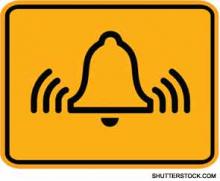User login
A Joint Commission Sentinel Event Alert released this spring tackles “alarm fatigue” resulting from the constant beeping of medical-device alarms and information being broadcast from these devices. If not properly managed, the proliferation of alarms can put hospitalized patients at serious risk because the barrage of warning noises can desensitize professional caregivers or distract them from truly critical alarms. U.S. Food and Drug Administration data show that 566 hospital deaths from 2005 to 2008 were alarm-related, while the Joint Commission’s own sentinel-events database lists 80 alarm-related deaths in the same period.
The commission urges hospital leaders to look at this serious patient-safety issue. “By making alarm safety a priority, lives can be saved,” said Ana McKee, MD, the commission’s executive vice president and chief medical officer.
Among its recommendations:
- Ensure that there is a process for safe alarm management and response in high-risk areas;
- Prepare an inventory of alarm-equipped medical devices in these high-risk areas;
- Regularly inspect, check, and maintain the devices; and
- Establish guidelines for alarm settings, including situations in which alarm signals are not clinically necessary.
The commission, which participated in a 2011 summit of national safety and medical-technology organizations seeking solutions to the problem, is considering the possible promulgation of a national patient-safety goal on alarm fatigue, a draft of which was field-tested in February and released for public comment.
Larry Beresford is a freelance writer in San Francisco.
A Joint Commission Sentinel Event Alert released this spring tackles “alarm fatigue” resulting from the constant beeping of medical-device alarms and information being broadcast from these devices. If not properly managed, the proliferation of alarms can put hospitalized patients at serious risk because the barrage of warning noises can desensitize professional caregivers or distract them from truly critical alarms. U.S. Food and Drug Administration data show that 566 hospital deaths from 2005 to 2008 were alarm-related, while the Joint Commission’s own sentinel-events database lists 80 alarm-related deaths in the same period.
The commission urges hospital leaders to look at this serious patient-safety issue. “By making alarm safety a priority, lives can be saved,” said Ana McKee, MD, the commission’s executive vice president and chief medical officer.
Among its recommendations:
- Ensure that there is a process for safe alarm management and response in high-risk areas;
- Prepare an inventory of alarm-equipped medical devices in these high-risk areas;
- Regularly inspect, check, and maintain the devices; and
- Establish guidelines for alarm settings, including situations in which alarm signals are not clinically necessary.
The commission, which participated in a 2011 summit of national safety and medical-technology organizations seeking solutions to the problem, is considering the possible promulgation of a national patient-safety goal on alarm fatigue, a draft of which was field-tested in February and released for public comment.
Larry Beresford is a freelance writer in San Francisco.
A Joint Commission Sentinel Event Alert released this spring tackles “alarm fatigue” resulting from the constant beeping of medical-device alarms and information being broadcast from these devices. If not properly managed, the proliferation of alarms can put hospitalized patients at serious risk because the barrage of warning noises can desensitize professional caregivers or distract them from truly critical alarms. U.S. Food and Drug Administration data show that 566 hospital deaths from 2005 to 2008 were alarm-related, while the Joint Commission’s own sentinel-events database lists 80 alarm-related deaths in the same period.
The commission urges hospital leaders to look at this serious patient-safety issue. “By making alarm safety a priority, lives can be saved,” said Ana McKee, MD, the commission’s executive vice president and chief medical officer.
Among its recommendations:
- Ensure that there is a process for safe alarm management and response in high-risk areas;
- Prepare an inventory of alarm-equipped medical devices in these high-risk areas;
- Regularly inspect, check, and maintain the devices; and
- Establish guidelines for alarm settings, including situations in which alarm signals are not clinically necessary.
The commission, which participated in a 2011 summit of national safety and medical-technology organizations seeking solutions to the problem, is considering the possible promulgation of a national patient-safety goal on alarm fatigue, a draft of which was field-tested in February and released for public comment.
Larry Beresford is a freelance writer in San Francisco.
